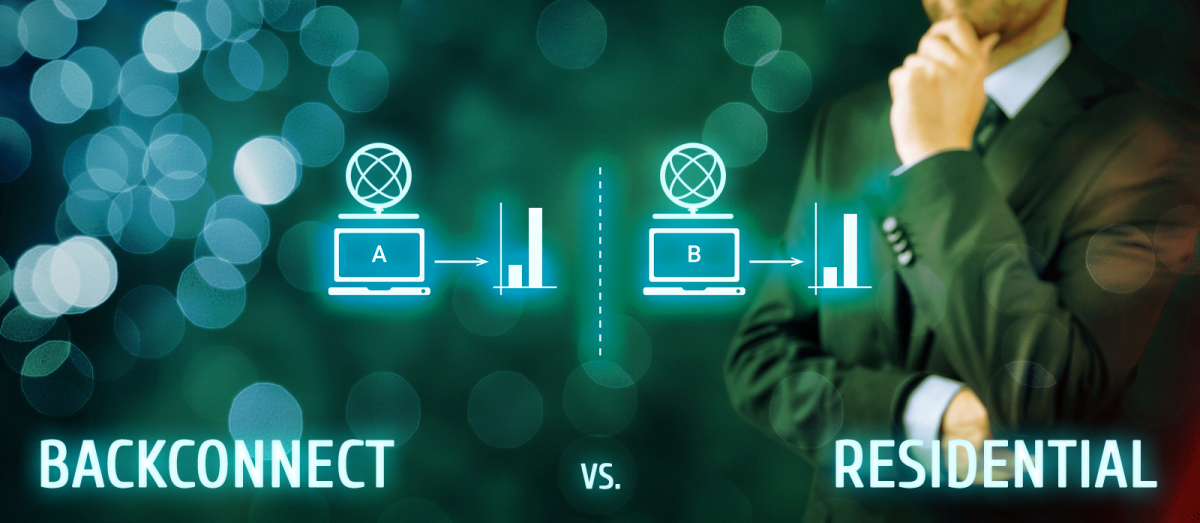Any time that you want to use a lot of proxies, you’ll probably want to use a bot to do the majority of the task for you. Most likely, you will be conducting a bulk search query, harvesting data from a variety of websites, or something similar to that. Now, you might be onto the next big automated app that requires a lot of web crawling, but this probably won’t be an effective app unless you know how to avoid the blocks you’ll run into when crawling. This is where learning the difference between backconnect and residential proxies becomes so important. The thing is, you don’t want to get your proxies banned while they are slaving away harvesting data for you at the risk of their own lives. If they were banned, your data collection will not be complete and, if your data vacillates from moment to moment, your table will be unusable. You know how frustrating it is when you are trying to download something and someone either cuts off the Wi-Fi or your computer turns itself off? It’s the same thing – all of the data has to download in order for your programs to be able to make use of it. Probably, by the time you discover the error, it’ll be close to your deadline. You’ll have to frantically set up new proxies to finish harvesting the data, and by that time your first collection will probably have changed and you will have just wasted an entire day of work.
The scenario above may not be what happens to you, but it’s undeniable that it is extremely frustrating to find that the IP of your proxy has been banned right when you are counting on getting some work done. At best, it will waste your time, forces you to exert more resources than you should have to repairing the damage and prevents your task from being conducted smoothly. That’s why it’s important to make sure you are taking steps to ensure your IPs aren’t banned before you get to work.
In order to understand how to avoid bans on your IPs, it’s important to know how sites are able to detect a proxy IP. The items in the following list are commonly identified by websites as red flags:
• Multiple queries coming in from a geo-location that the site deems to be irrelevant
• Multiple identical queries coming in at once
• Multiple queries coming in from the same web browser
• Multiple queries coming in using high risk or flagged terms
The two types of proxies that we will cover today are backconnect proxies and residential proxies.
In essence, backconnect proxies work the same way that normal proxies work. The configurations are identical and the pros and cons are, for the most part, the same. The main difference between a standard proxy and a backconnect proxy lies within the network itself (or the server, depending on how you look at it).
Unlike normal proxies, backconnect proxies aren’t composed of a single unit that forwards data and serves it with different referrers and headers, but are instead a multitude of different configurations and different machines linked together. You can have 50, 500 or 50,000 proxies all linked together that you connect to from a single gateway or “backconnect proxy.”
The reason you would want to have a backconnect proxy is so that you can alter your IP and referrer data, just like you would with a standard proxy server. The main difference in the way that the two types of proxies handle data can be a little difficult to understand, so an example has been provided below.
With a normal proxy server, you will be sending data from point A to point B. Every connection that is made through the proxy will come out as B. Even if you decide that you want to have a list of proxies that rotates, it will be a steady pattern of B, then C, then D and then back to B. These patterns, cycles and footprints are easy to track.
There are backconnect proxy providers out there who state that they have databases composed of millions of proxies, with upwards of 100,000 available on any given day. Some providers allow you access to proxies from specific locations like USA-only, and make use of numerous protocols like HTTP, SOCKS, or HTTP/S.
The biggest benefit of using a backconnect proxy pool is that you will have the ability to make considerably more requests each minute than if you were using a single connection. If Bing notices that numerous connections are coming from server A without a break, the site may automatically require a “captcha” on all actions involved. Even if you are able to pass it with your proxies, multiple connections will definitely limit your rate. If you’re using a backconnect proxy, every connection that is made will be sent through a different IP address and will access the website from a different connection point.
There are two major drawbacks when it comes to using a backconnect proxy pool. The first is the cost. Accessing a list of backconnect proxies is typically very expensive since you’re allowed access to a lot of IPs. The second drawback is the fluctuating quality of the proxies you obtain. Some of your connections will be blazing fast and some of them will be as slow as that old lady in front of you on the highway; this does depend on the provider you choose and the proxies in their backconnect proxy pool. If the backconnect proxy pool connects you to residential proxies, fluctuations in speed should be expected, since you’re connecting through normal broadband connections.
When you obtain backconnect proxies from a trustworthy source, you will be able to scrape information from search engines and the web without having to worry about your IP address getting blocked. This is made possible by the highly advanced technology available today that offers you with many thousands of totally private IP address that will be able to be rotated whenever you initiate a request.
Backconnect proxies from reputable companies will always be anonymous and will offer automatic IP rotation with each account. The rotating proxies will allow you to get significantly more search requests with each command than you would with just one proxy. To put things another way, the search engine or web page you are scraping will perceive the requests to be coming from a variety of locations rather than a central IP port, so this dramatically reduces your chances of being blocked.
A Comparison of Backconnect Proxies and Residential Proxies
Residential Proxies
Residential proxies are web servers that are used for filtering data and increasing anonymity between you and the website that you’re trying to access. When you attempt to access a website normally, you will send out a request from your browser. The request goes through the modem and router into a street level router. From there, it will travel through the neighborhood router, to an ISP server and into an internet backbone. Then the information will be accessed and everything will work in reverse back to the server to which you are connecting. Many times, more advanced servers are equipped with a direct connection to internet backbones, which makes it less likely that your data can get intercepted or scrambled en route.
Residential proxies essentially operate as a middle man. Usually, the physical location of a proxy is in some foreign country, which will require the connection to have to cross the ocean, beam to a satellite, or receive some kind of wireless transmission so that it can reach its destination. It’s not necessary for a proxy server to be a reserved, dedicated server or high powered piece of hardware. As a matter of fact, if your computer is configured correctly, you can turn it into a proxy server with minimal trouble. The direct connection will simply travel from the computer, into a series of routers and from there into the web host server where the website you are trying to access lives. The data you are trying to obtain will then be collected and the connection will return on its previous route to deliver you the information that you are looking for. This information can be anything from a page loading text to a specialized web application.
When you use a proxy, the connection will depart from the computer and travel through the wonderful world of routers or servers until it reaches the proxy. It will then forward the connection to the server through standard web request protocols (like SOCKS, HTTP and HTTP/S). The web server will respond to the request (although it will record the altered data that the proxy sent it rather than your actual data) and the data will then be sent back to the proxy. The proxy server will then thoughtfully forward the data back to you.
There are numerous ways that you can configure a standard proxy server. It can be public, open for general use or private. They can be used to transmit data without it being altered or they can be used to send ads. They tend to be beneficial if you are looking for anonymity and security. Backconnect proxies are more secure than residential proxies since they change your IP so often, but tend to be more beneficial for the scraping of bulk data and not for the causal browsing that you conduct every day.
Backconnect Proxies
Most backconnect proxies feature a rotation feature. Whether it is 5 minutes, 10 minutes or more; this IP rotation ensures you’re always making requests to sites from a fresh IP that isn’t blacklisted. Backconnect proxies change the IP and referrer data just like residential proxy servers; some backconnect proxies give you access to a pool of many residential proxies. With other types of backconnect proxies, each time that you send out a connection or request, the proxy’s IP will change. This means that you leave virtually no footprint during your scraping procedures and will really not need to worry about having your IP address blocked.
The difference between backconnect and residential proxies is huge. Backconnect proxies connect you to a pool of many IPs, while residential proxies represent static residential IP addresses that you can pass requests through. If you’re just trying to browse the web, static residential proxies are best. If you’re doing more advanced things like account creation, using SEO software or crawling the web, backconnect proxies will reign supreme.

